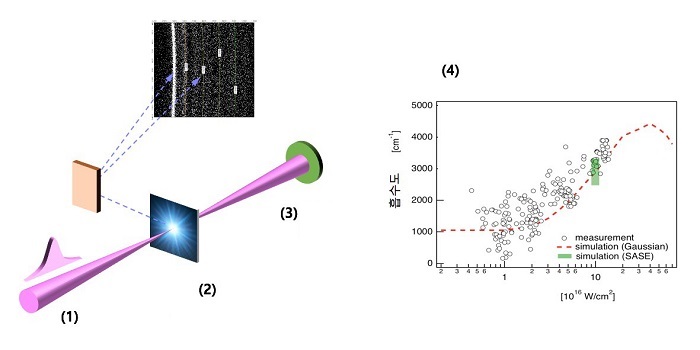2017.08.29
Professor Byoung-Ick Cho of the Department of Physics and Photon Science at the Gwangju Institute of Science and Technology (GIST, President Seung Hyeon Moon) has discovered a new phenomenon whereby the X-ray transmittance of aluminum changes nonlinearly as the X-ray intensity increases.
X-rays have a shorter wavelength than visible light and has the advantage of being able to penetrate the internal structure of an object. However, nonlinear photonics applications using strong lasers are actively studied in the visible light region, but the brightness of the X-ray is relatively weak and applications for utilizing the nonlinear phenomenon is considered difficult.
When an x-ray free-electron laser pulse was focused at a level of 1 micrometer, the light transmittance of the X-ray decreased to less than 1/4 of that in a conventional case.
This means that the intensity of light can be controlled by controlling the x-ray transmittance or absorption of the substance. In addition, a comparison with computational simulation using a collision - radiation model reveals that this phenomenon is reverse saturation absorption, a kind of nonlinear phenomenon known to be difficult to occur in conventional x-ray science.
This study shows that when x-rays generated from the 4th-generation synchrotron radiation system irradiates aluminum with a brightness of up to 10 billion or more than that of conventional x-rays, the reverse saturable absorption phenomenon occurs. It is expected that X-ray photonics applications, such as development of x-ray nano-microscope using nonlinear x-ray technology and the development of super-strong x-ray laser will be possible.
Professor Byoung-Ick Cho said, "This result shows the possibility of expanding the nonlinear photonics technology that has been in the visible light region to also include x-rays. This can be applied to various fields, such as x-ray confocal microscopes that can see specific nano structure inside of materials, ultra-high speed optical modulators that can adjust the property of x-ray pulses, and ultra-strong x-ray laser."
Their paper entitled "Observation of Reverse Saturable Absorption of an X-ray Laser" was authored by B. I. Cho, M. S. Cho, M. Kim, H.-K. Chung, B. Barbrel, K. Engelhorn, T. Burian, J. Chalupský, O. Ciricosta, G. L. Dakovski, V. Hájková, M. Holmes, L. Juha, J. Krzywinski, R. W. Lee, Chang Hee Nam, D. S. Rackstraw, S. Toleikis, J. J. Turner, S. M. Vinko, J. S. Wark, U. Zastrau, and P. A. Heimann and published in Physical Review Letters on August 16, 2017.















